Raucous ‘Anora’ features unique story; standout acting by Mikey Madison
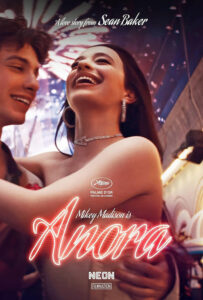 By Steve Crum
By Steve Crum
Feature movies with a prostitute as the main character have existed for nearly a century. They include Anna Christie with Greta Garbo, Rain (Joan Crawford), Klute (Jane Fonda), Irma la Douce (Shirley MacLaine), Pretty Woman (Julia Roberts), and Midnight Cowboy (Jon Voight).
Add Mikey Madison to that stellar list. Make that the Oscar nominated Mikey Madison. She memorably portrays the title character in Anora. (The film has received five other Oscar noms as well, including Best Picture.)
 Everyone in the cast is way above average, including Yura Borisov as Igor. (He is an Oscar nom for Best Supporting Actor.) Sean Baker (The Florida Project) is director, producer, screen scribe and editor—all nominated. All said, the combination of that creativity results in a unique and unforgettable film.
Everyone in the cast is way above average, including Yura Borisov as Igor. (He is an Oscar nom for Best Supporting Actor.) Sean Baker (The Florida Project) is director, producer, screen scribe and editor—all nominated. All said, the combination of that creativity results in a unique and unforgettable film.
Anora is touted as an “American comedy drama,” which indeed it is. It is also wild, raucous, and sexually explicit. Label it Super-R. The story opens in Anora (“Ani”) Mikheeva’s (Mikey Madison) main workplace, a strip club brothel in New York City. Her prostitution demands sometime take her and a client to a nearby location outside the club. That scenario occurs when she hooks up (yeah, a pun) with a Russian young man, Ivan (“Vanya”) Zakharov, a man-child played by Mark  Eydelshteyn. After some horizontal activity in a back room at the club, Ivan insists Anora party with him for a week ($15,000) while staying in his rich parents’ nearby mansion. Mom and Dad are still in Russia.
Eydelshteyn. After some horizontal activity in a back room at the club, Ivan insists Anora party with him for a week ($15,000) while staying in his rich parents’ nearby mansion. Mom and Dad are still in Russia.
The set-up escalates into a private plane trip to Las Vegas, more sex…and marriage! They return to NYC, word gets out to Ivan’s parents, and the outraged family calls on their hired fixer, an Armenian priest, to retaliate. In one of the funniest bits in the film Toros (Karren Karagulian), the head handler, is in the middle of a christening when he gets a call to dissolve Ivan and Anora’s marriage. He immediately responds, running out of the ceremony and taking two of his strong arms with him: Igor and Garnik (Vache Tovmasyan).
 Be prepared for pushback from the newlyweds: screaming, threats, throwing things, tying up, barfing, a couple of car escapades, and general chaos. Everything escalates when the Russian parents arrive to make things worse.
Be prepared for pushback from the newlyweds: screaming, threats, throwing things, tying up, barfing, a couple of car escapades, and general chaos. Everything escalates when the Russian parents arrive to make things worse.
Much of Anora’s dialogue is laced with foul language, particularly the f-word. In fact, her lines are a close runner-up to the nasties in 1992’s Glengarry Glen Ross. Then again, Anora’s use seems totally natural and expected. She uses the word as both punctuation and angry leverage.
By the story’s resolution, Anora has withstood numerous challenges. A happy ending? Not necessarily.
Up to and particularly including the last 30 minutes of this 139-minute gem of originality, I had zero idea where the story was going. Thusly, my affection for this terrific movie was a given.
—————
GRADE on an A-F Scale: A
Angelina Jolie believable as eccentric opera singer Callas in ‘Maria’
 By Steve Crum
By Steve Crum
“PRIVILEGE.” It is an apt alternate title I would give to Maria, the fascinating biopic of world renowned opera singer Maria Callas, starring Angelina Jolie. To say that Maria Callas was spoiled is to put it, um, mildly. Accurately described as as a “biographical psychological drama,” the film’s production is the result of an international collaboration encompassing the United States, Chile, Great Britain, Italy and Germany. For example, Director Pablo Larrain (Jackie) is Chilean; Screenwriter Steven Knight is British.
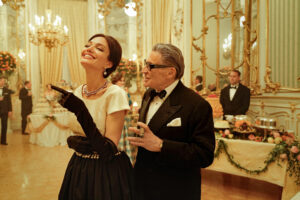 The story opens during the final day of Maria Callas (Sept. 16, 1977), and continues for the next 124 minutes in flashbacks…and flashbacks within flashbacks. To offset confusion, past incidents appear in black and white. The narrative is still confusing, particularly when Maria has distorted recollections (hallucinations) due to her ill health—influenced by drugs, fantasies, and memory loss. She suffers mental demons, viewed through her recollections. Expect lapses in truth and rumor like whether or not the young Maria was forced to sing for the Nazi SS…or her relationship with Aristotle Onassis (well portrayed by Haluk Bilginer).
The story opens during the final day of Maria Callas (Sept. 16, 1977), and continues for the next 124 minutes in flashbacks…and flashbacks within flashbacks. To offset confusion, past incidents appear in black and white. The narrative is still confusing, particularly when Maria has distorted recollections (hallucinations) due to her ill health—influenced by drugs, fantasies, and memory loss. She suffers mental demons, viewed through her recollections. Expect lapses in truth and rumor like whether or not the young Maria was forced to sing for the Nazi SS…or her relationship with Aristotle Onassis (well portrayed by Haluk Bilginer).
Her need to be pampered and the center of attention is explored. As depicted, she stops by a favorite eatery in Paris. “I’m not hungry,” she tells the waiter. “I come to restaurants to be adored.”
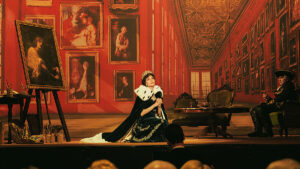 During her prime, Callas was considered THE prima donna opera singer. With a yet unequalled singing range, she exuded professionalism and showmanship on major stages around the world.
During her prime, Callas was considered THE prima donna opera singer. With a yet unequalled singing range, she exuded professionalism and showmanship on major stages around the world.
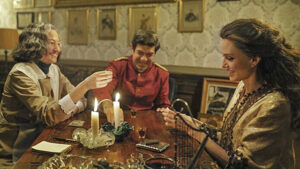 Yet, as shown in the film, she is fraught with vocal insecurity. Scattered memories surround her fear of never singing again as she grows older.
Yet, as shown in the film, she is fraught with vocal insecurity. Scattered memories surround her fear of never singing again as she grows older.
As the film slowly (too slowly) progresses, it reminded me in several ways of Albert and David Maysles’ 1987 documentary, Grey Gardens. Even though Maria is not a documentary, it has a similar feel in its mixture of grandeur and former grandeur. Sadness permeates both films.
That sadness is somewhat balanced with friendship via the dedicated and loving relationship between Callas and her longtime servants, expertly portrayed by Pierfrancesco Favino as her butler, Ferruccio—loyal to the hilt, and Alba Rohrwacher’s Bruna, the housemaid.
 Angelina Jolie shines as Callas, not only in terms of acting but expertly lip synching to the diva’s original recordings. It is Jolie herself superbly singing at the movie’s conclusion. Her seven months in vocal training paid off!
Angelina Jolie shines as Callas, not only in terms of acting but expertly lip synching to the diva’s original recordings. It is Jolie herself superbly singing at the movie’s conclusion. Her seven months in vocal training paid off!
Kudos to the awesome location filming (in and outdoors) by cinematographer Edward Lachman.
And bravo to Jolie, whose acting (and singing) chops have risen to Oscar level since those long ago Tomb Raider days—not saying that she wasn’t an impressive action star.
—————
Supernatural elements negatively affect ‘The Piano Lesson’
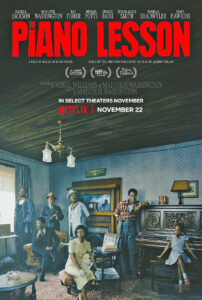 By Steve Crum
By Steve Crum
It was less than a delightful experience viewing The Piano Lesson. Based upon August Wilson’s Broadway play of the same name and directed-adapted by Malcolm Washington, The Piano Lesson is a study in family values and characterizations. Its strength is in the superb acting, supported by rich dialogue.
It is an ensemble piece, par excellence.
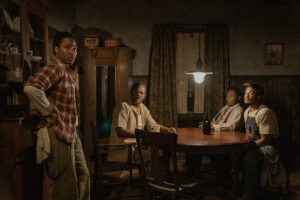
Umbrage has to be taken, however, with expectations. Specifically, TPL is advertised as a “drama”—which is valid. From the outset, the story “presents realistic characters who deal with realistic conflicts or struggles.” (Thank you, Mr. Webster.)
However, exploding during the third act of this 127-minute tale is a supernatural aspect best described as “horror.” Ghostly, violent things occur. It all pertains to the family and friends inside the house, which is the primary setting. So why isn’t The Piano Lesson truthfully promoted as drama/horror? A petty observation? I don’t think so.
Consider the plot line, which Virgil Williams co-adapted. Utilizing flashbacks to tell the history of the piano that centers the story, the tale opens on July 4, 1911 in Mississippi. The wealthy Sutter family is enjoying fireworks miles away from home as their estate is being ransacked. Specifically, their piano is stolen. The thieves include 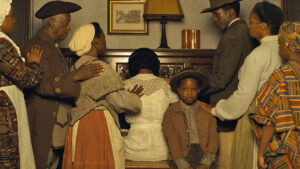 the Black ancestors of the Sutters’ former slaves, the Charles Family. It turns out that the piano has intricately carved faces across the front and sides. The faces are of the Sutter slaves.
the Black ancestors of the Sutters’ former slaves, the Charles Family. It turns out that the piano has intricately carved faces across the front and sides. The faces are of the Sutter slaves.
Continuing in flashback, the Sutters eventually catch up with a perpetrator (Boy Charles) while the piano is separately transported by others up north—never to be returned.
In a flash-forward to 1935 Pittsburgh, Boy Charles’ son Boy Willie (John David Washington), rides a wagon to town to visit his sister Berniece  (Danielle Deadwyler). She is the single mother of daughter Maretha (Skylar Aleece Smith). Both live with Uncle Doaker, played by Samuel L. Jackson. They live in an impressive two-story house…with that gorgeously carved piano standing in the living room.
(Danielle Deadwyler). She is the single mother of daughter Maretha (Skylar Aleece Smith). Both live with Uncle Doaker, played by Samuel L. Jackson. They live in an impressive two-story house…with that gorgeously carved piano standing in the living room.
So goes the initial plot, as Boy Willie wants to sell the piano, which he claims as co-owner with his sister. His sister vehemently objects, and seemingly endless arguments ensue. A half dozen other characters get involved over time, including a wanna be preacher Avery (Corey Hawkins), who wants to marry Berniece.
As referenced earlier, the final third of TPL involves the ghost of Old Man Sutter seeking vengeance via apparitions, spooky sounds, and downright physical fighting—particularly with Boy Willie. As effective as the chills are, they seem trite to advance the story. And the story’s finality is a sugar-coated letdown.
 The Piano Lesson is the third of three August Wilson plays produced for films by Denzel Washington. Like Fences and Ma Rainey’s Black Bottom, it features Black characters fusing history with human values.
The Piano Lesson is the third of three August Wilson plays produced for films by Denzel Washington. Like Fences and Ma Rainey’s Black Bottom, it features Black characters fusing history with human values.
So why taint it with a partial reworking of The Amityville Horror?
—————
GRADE on an A-F Scale: C
‘Heretic’ terrifies as house of horrors tale starring well spoken, lethal Hugh Grant
 By Steve Crum
By Steve Crum
Of the dozens and dozens of movies about haunted houses ever produced, there are some standouts. (I am not counting the comedy hh movies, led by The Ghost and Mr. Chicken.) Still scary are House on Haunted Hill, The Amityville Horror, and The Others. The best of the bunch remains a tie between 1963’s atmospheric The Haunting and 1944’s The Uninvited.
 Now we have 2024’s Heretic, a foreboding horror movie co-directed and written by Scott Beck and Bryan Woods. The duo have restructured the standard haunted house formula with the violence of Saw. Then add a huge dose of faith elements.
Now we have 2024’s Heretic, a foreboding horror movie co-directed and written by Scott Beck and Bryan Woods. The duo have restructured the standard haunted house formula with the violence of Saw. Then add a huge dose of faith elements.
As opposed to Beck and Woods’ 2018 horror hit, the well named A Quiet Place, Heretic is packed with 111 minutes of nearly nonstop sounds of religious discussion (mainly by Hugh Grant’s character), as well as creaks, moans and screams. (Cue the sound effects!)
Mr. Reed (Grant) is the heretic of the title, a guy who claims he has studied Christianity and other religions. Yet he lives alone in this secluded old mansion, unable to discuss his knowledge. It turns out to be extremely biased “knowledge.” He yearns to share what he has learned with the front  that he is interested in Mormonism. Naturally, Mr. Reed requests the Church of Jesus Christ of Latter-day Saints to send a couple of missionaries to his home. In quick time, the two missionaries, Sister Barnes (Sophie Thatcher) and Sister Paxton (Chloe East), are knocking at his door…at sundown on a rainy, windy day.
that he is interested in Mormonism. Naturally, Mr. Reed requests the Church of Jesus Christ of Latter-day Saints to send a couple of missionaries to his home. In quick time, the two missionaries, Sister Barnes (Sophie Thatcher) and Sister Paxton (Chloe East), are knocking at his door…at sundown on a rainy, windy day.
The two reluctantly come inside, even though Reed’s wife is nowhere to be seen. “She’s in the kitchen,” he says.
So begins a lethal game of wits, fear, and detective work on the part of the young ladies.
 The story escalates into terror once it is discovered the front door is locked and now unusable. Creepy becomes CA-REEPY. The women are imprisoned.
The story escalates into terror once it is discovered the front door is locked and now unusable. Creepy becomes CA-REEPY. The women are imprisoned.
Prepare for their wild ride of making a “Lady or the Tiger” choice; Mr. Reed’s unending mind games; a visit from a cloaked prophet (?); and touring the house mazes. It is all familiar territory for a haunted house story, held together by the extraordinary work of Hugh Grant.
Who knew he could be so hellishly manipulative and controlling?
—————
GRADE on an A-F Scale: B-
‘Sing Sing’, headlined by Colman Domingo, features unique storyline
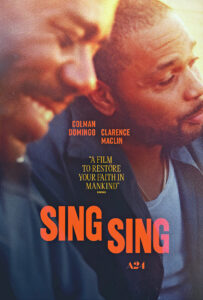 By Steve Crum
By Steve Crum
There has never been a prison movie like Sing Sing. However, Director-Screenscribe Greg Kwedar’s heartfelt drama perfectly fits within the sub-genre of American Prison Films. The traditional prison flick was established with 1930’s The Big House. (A year later, Laurel and Hardy hilariously parodied with Pardon Us.) Dozens of “Big House” stereotypes followed, including, egad, the wildly titled 20,000 Years in Sing Sing. More recent titles re-established the genre with Escape From Alcatraz and the widely regarded The Shawshank Redemption.
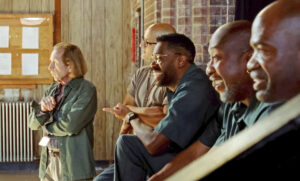
2024’s Sing Sing is cut from a different inmate cloth.
It looks and feels differently. Kwedar utilizes closer to a cinema vérité storytelling technique. In its documentary-reminiscent style, the focus is on stark characterizations rather than—say—planning for a breakout or violence involving the warden. The many facial closeups serve the purpose of knowing and caring about these cons.
The fact-based story’s main character is John “Divine G” Whitfield, brilliantly portrayed by Colman Domingo. He is an innocent man who has been wrongly found guilty of murder and now jailed at Sing Sing Correctional Facility (located in Ossining, NY). Divine G is also a driving force for the prison’s innovative RTA (Rehabilitation Through the Arts) Program. Plus he is the star actor and playwright. As such, he is the primary recruiter for new members to join the acting troupe. The very popular small group truly love 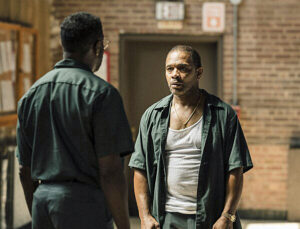 their theatrical work and regularly perform plays and cuttings by the likes of Shakespeare to Divine G. Add Brent Buell (Paul Raci) as a civilian who volunteers to direct and write many of the plays. Costuming, sound and lighting add to the mix. He works alongside Divine G. in getting the casting, rehearsals and presentations to the inmate population. This all occurs in the prison’s gymnasium, which includes a small stage.
their theatrical work and regularly perform plays and cuttings by the likes of Shakespeare to Divine G. Add Brent Buell (Paul Raci) as a civilian who volunteers to direct and write many of the plays. Costuming, sound and lighting add to the mix. He works alongside Divine G. in getting the casting, rehearsals and presentations to the inmate population. This all occurs in the prison’s gymnasium, which includes a small stage.
Running 105 minutes, Sing Sing’s drama balances the member recruiting, particularly regarding the reluctant Divine Eye (Clarence Maclin), with the personal challenges of cast members—like parole issues  and stage fright. It often feels like we are witnessing a play within a play. Yet that irony is so compelling and believable.
and stage fright. It often feels like we are witnessing a play within a play. Yet that irony is so compelling and believable.
Speaking of irony, most of the main cast members are actual former inmates at Sing Sing. That includes Maclin, who turns out to be a fine actor. And current convicts are seen as extras. The film itself becomes a rehabilitation influence. The cinema vérité technique also extends to the director’s use of a handheld 16mm camera; and utilizing Sing Sing and two other prisons as shooting locations. (The limited budget had much to do with those choices.)
Sing Sing is sensitive without being saccharine—sometimes elating, sometimes tearful. It deserves accolades.
—————
GRADE on an A-F Scale: A-
